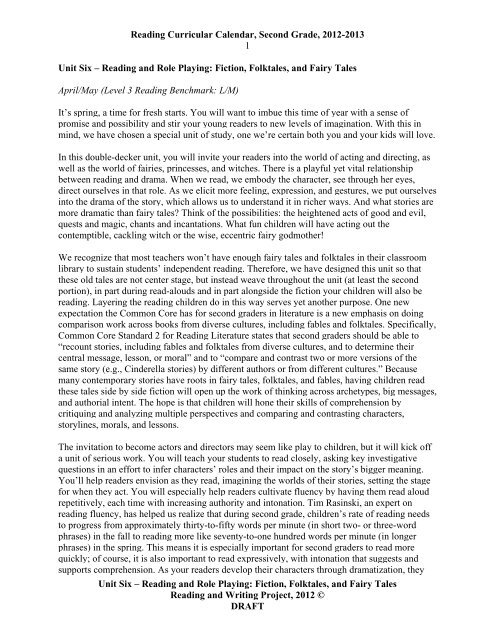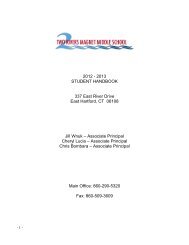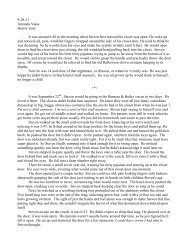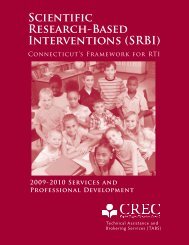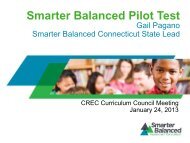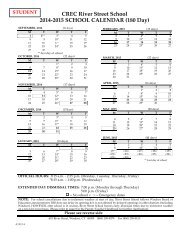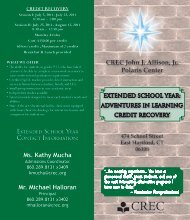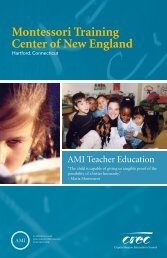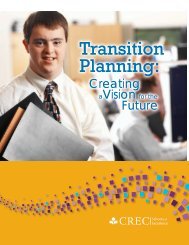Reading and Role Playing: Fiction, Folktales, and Fairy Tale
Reading and Role Playing: Fiction, Folktales, and Fairy Tale
Reading and Role Playing: Fiction, Folktales, and Fairy Tale
You also want an ePaper? Increase the reach of your titles
YUMPU automatically turns print PDFs into web optimized ePapers that Google loves.
<strong>Reading</strong> Curricular Calendar, Second Grade, 2012-20133viewpoints, brings out two distinct meanings. As you plan your instruction for this unit, then,you will want to consider what you have taught in prior units, <strong>and</strong> how you can build on thatwork in ways that deepen <strong>and</strong> extend children’s reading skills <strong>and</strong> comprehension.AssessmentThis is an important time to assess your readers, who are quickly nearing the completion ofsecond grade. Readers who were assessed in March may well be ready to move up to the nextlevel. And in general, you’ll want to do what you can to help move kids up the levels of textdifficulty—to be sure that all your students are making a year’s growth. Kids who entered atlevel J should be at level L, approaching M. Kids who entered above grade level, around levelM, will now be at level O, approaching P. Any students who entered below grade level, aroundlevel F or G, should also have made great gains in the year. Many of those readers should be atlevel K, working toward L. Some of them will be ready to move up to another level of textdifficulty. The good news is that your students will be reading fiction books this whole month—so now is a good time to think about making those books more challenging for those who areready. If some readers have not progressed as you’d expected over the course of the year, now isan essential time to intervene. Do these readers need to spend an hour after school, in thebuilding, reading? Do they need to double the amount of reading they are doing at home?Now is also a good time to push your students toward deeper reading comprehension. Certainly,you’ll want to be sure that children are at or nearing benchmark level for Grade Two on theLiterature <strong>Reading</strong> Continuum. They should be able to infer character traits <strong>and</strong> feelings, as wellas the central problem in a story. Moreover, they should carry their inference work across entiretexts, thinking about how the circumstances <strong>and</strong> characters’ feelings change across a story, <strong>and</strong>how these shifts, taken together, create a story not just of happenings, but of meaning. That is,you’ll want your students to underst<strong>and</strong> that stories are imbued with significance, which a readeraims always to uncover. Many second graders, when asked what a story is really about, will tendto retell the entire story rather than inferring a larger meaning. That is, they will rely on thefoundational skill of recall (DOK Level 1). At this stage, readers should be able to process thestory a bit (DOK Level 2), perhaps comparing one character’s response to anther’s. Somestudents may relay a generalized topic—“Friendship”—or a brief summary of the book—movingto the country—rather than naming a theme or specific lesson. As you nudge these children tosay more, help them underst<strong>and</strong> that readers talk in sentences not single words to describe what abook is really about, <strong>and</strong> that they dig deeply, thinking beyond the literal actions of characters totalk about them.As you assess for comprehension, be on the lookout for signs of yet more sophisticated work thatWebb describes as strategic thinking (Level 3). For second graders, this means reading <strong>and</strong>responding to books purposefully, drawing independently from a repertoire of strategies as theyread, supporting their thinking with evidence in the text, <strong>and</strong> the ability to consider differentpossibilities when attempting to underst<strong>and</strong> various characters’ responses <strong>and</strong> motivations.Beyond this, you’ll want to assess for Level 4 work, which Webb describes as extended thinking.That is, can your students apply what they are learning in this one unit of study to other contexts?Can they draw connections, make meanings, think more universally than just across the texts thatthey read in this classroom, this unit? <strong>Fairy</strong> tales <strong>and</strong> folktales are laden with meaning. The oftenheavy h<strong>and</strong>ed messages of these antiquated tales are an opportunity for deeper thinking becauseUnit Six – <strong>Reading</strong> <strong>and</strong> <strong>Role</strong> <strong>Playing</strong>: <strong>Fiction</strong>, <strong>Folktales</strong>, <strong>and</strong> <strong>Fairy</strong> <strong>Tale</strong>s<strong>Reading</strong> <strong>and</strong> Writing Project, 2012 ©DRAFT
<strong>Reading</strong> Curricular Calendar, Second Grade, 2012-20134they invite debate. Then, too, students will be reading modern books side by side these tales, <strong>and</strong>can think comparatively <strong>and</strong> beyond about issues such as good <strong>and</strong> evil <strong>and</strong> everything inbetween, about the predictable roles they encounter, not only in these books, but in life, about thelessons books <strong>and</strong> authors suggest, <strong>and</strong> whether they see these sorts of messages elsewhere...orperhaps the opposite. They can consider their own views, too, talking back to the texts. You’llwant to see that kids are on these lines of thinking, <strong>and</strong> if not, make plans for how to bolster thiskind of work.Bend One – Readers Can Become Actors Too: Stepping into a Character’s Shoes—Literally!On the first day of the unit you might gather your children <strong>and</strong> say something like this: “Secondgraders, I was watching TV with my nephews over winter vacation <strong>and</strong> guess what show I saw?Little Bill! I couldn’t believe it. It was the episode “The Meanest Thing to Say.” What acoincidence! Right after we studied <strong>and</strong> read so many Little Bill books, our favorite characterwas alive! It was so neat to see the characters come to life that way, moving <strong>and</strong> talking. Iglanced at the cartoon schedule <strong>and</strong> guess what? There were a couple other class favorites, too—Franklin <strong>and</strong> Little Bear. It made me think that any of our books could become dramas! And thatgot me thinking that maybe, just maybe, all of you would like to be one of those actors. Are yougame?”Then, you can read aloud a book the class knows well (preferably one that has been made into acartoon or movie), setting children up to reenact as they listen. You’ll want to throw yourself intothe dramatization of the book, making facial expressions, gesturing with your h<strong>and</strong>s <strong>and</strong>shoulders— your whole body if need be—<strong>and</strong> making your voice change for each character.You’ll invite children to join you as actors, not by st<strong>and</strong>ing up <strong>and</strong> moving around as you readaloud, but in their spots on the rug. It is amazing how much acting can be done while sitting inplace! You can read a passage aloud <strong>and</strong> then stop <strong>and</strong> say, “How about if we try it—right here,right now? I’m going to reread the part of The Meanest Thing to Say when Little Bill is at home,trying to decide what to do now that Michael, the new kid at school, has challenged him to thinkof the meanest thing he could say. So right now, while you are sitting here, will each of you beLittle Bill? He’s in his kitchen with his great-gr<strong>and</strong>ma <strong>and</strong> his parents. Think about what thatlooks like. Be the best Little Bill you can be. What does his face look like? Show me on yourface what you are feeling as him. Are his arms crossed? Remember, you are trying to think ofsomething really mean to say to Michael.”Halfway through the book <strong>and</strong> again at the end, you might say something like, “Right now think,‘What’s Little Bill thinking inside his head?’ Partner one, you be Little Bill <strong>and</strong> say thosefeelings aloud to partner two. Partner two, you’re Dad for now. Turn <strong>and</strong> talk.” As you listen inon these enactments, you may notice that some children think Little Bill is acting obnoxious,while others think Little Bill is just confused. You might decide to use this opportunity to tellchildren that not all actors interpret a character in the same way (just as not all characters share asingle point of view— CCSS RL 2.6) Or you could wait <strong>and</strong> do this sort of interpretive workanother day, during a second or third read-aloud/enactment. If you decide to do it today, youcould tell the class that you noticed different children interpreted Little Bill differently, <strong>and</strong>explain those differences. Then you could say something like “Let’s all try imagining this part ofthe story as being all about how Little Bill becomes more <strong>and</strong> more obnoxious. I’m going to readit again, <strong>and</strong> you all play the role of Little Bill, but this time, make him sort of snotty sounding.”Unit Six – <strong>Reading</strong> <strong>and</strong> <strong>Role</strong> <strong>Playing</strong>: <strong>Fiction</strong>, <strong>Folktales</strong>, <strong>and</strong> <strong>Fairy</strong> <strong>Tale</strong>s<strong>Reading</strong> <strong>and</strong> Writing Project, 2012 ©DRAFT
<strong>Reading</strong> Curricular Calendar, Second Grade, 2012-20135Then you could reread, suggesting children try out the theory that Little Bill is more confusedthan anything. Your read-alouds will carry a good part of this unit, <strong>and</strong> they will also set childrenup to meet several of the Common Core St<strong>and</strong>ards’ expectations for second grade readers. Forexample, they will prepare students to “describe how characters in a story respond to majorevents <strong>and</strong> challenges” (RL 2.2). Because the read-alouds for this unit involve not simplythinking <strong>and</strong> turning <strong>and</strong> talking about characters’ reactions, but physically stepping into theroles of characters, the result is that students will come away with a deeper underst<strong>and</strong>ing ofcharacter motivations <strong>and</strong> feelings.Of course, any unit of study is really going to be about the work you hope children will do ontheir own as they read. So after you’ve engaged the class in a dramatic read-aloud, you could sayto them, “Oh my gosh! You all are so good at becoming the character as you read! Which isgreat, because this month we’re going to be reading every story as if we are the characters.We’re going to be reading our stories like actors! This means that we’re going to step intocharacters’ shoes, thinking as we read, ‘I bet she’s really mad now,’ reading the words that thecharacter says in a mad voice as we furrow our brows <strong>and</strong> scowl, or, ‘I bet he’s a little scared inthis part,’ <strong>and</strong> then cowering a bit, <strong>and</strong> making our faces look frightened. And we’re going tonotice when a character’s feelings might be changing <strong>and</strong> make sure that the voice in our headchanges along with the character’s feelings. Each of you will be doing this work on your own asyou read, <strong>and</strong> later you’ll have a chance to act it out with your club.” The work you do withchildren during read-alouds, then, will scaffold them as they work on their own, in partnerships<strong>and</strong> eventually in clubs. The hope is that children will not only model what you do, but begin toengage in more independent, higher level reading work.Your first step will be to teach children to do some preliminary work noticing <strong>and</strong> interpretingthe details that tell us about a character. “Before readers can empathize, before we can role-playour way into a story,” you’ll tell kids, “we need to read very closely, noticing clues that will helpus learn more about the character. What sort of person is this character? Is he serious? Alwayscracking jokes? What does he like <strong>and</strong> dislike? What does he really, really want?” Becausechildren will have learned earlier in the year about the importance of paying close attention to thedetails that an author provides, you’ll have the chance now to remind them of the strategies fordoing this that you taught in November. Bring out those old charts on ways to track yourcharacter <strong>and</strong> think about his or her wants <strong>and</strong> troubles, <strong>and</strong> remind children of all they knowabout marking books with Post-its, noting things to talk about with their partner. You can tellthem that actors, too, keep notes as a way to get inside a character’s head <strong>and</strong> put themselves intothat role. By marking up their books, they’ll be doing likewise, preparing to bring out the thingsthey notice about the characters in their books.In addition to thinking about the “who” <strong>and</strong> “why” in a text (CCSS RL 2.1), this work also setschildren up to consider “how characters respond to major events <strong>and</strong> challenges” (RL 2.3), <strong>and</strong>,in part through that, to “determine a central message, lesson, or moral” (RL 2.2). We believe thatthis combination of reading, reflecting, note taking <strong>and</strong> acting bolsters not only their readingcomprehension, but also their depth of engagement with text <strong>and</strong> with characters.Next, you can help children not only pay attention to a character <strong>and</strong> his or her experiences butalso analyze how the character is feeling. To do this, your children will mark places in theirUnit Six – <strong>Reading</strong> <strong>and</strong> <strong>Role</strong> <strong>Playing</strong>: <strong>Fiction</strong>, <strong>Folktales</strong>, <strong>and</strong> <strong>Fairy</strong> <strong>Tale</strong>s<strong>Reading</strong> <strong>and</strong> Writing Project, 2012 ©DRAFT
<strong>Reading</strong> Curricular Calendar, Second Grade, 2012-20136independent reading books where the main character has a strong feeling with which theyempathize. When partners meet, one of the things they can do is to talk about the places wherethe character felt something especially intensely. They can read aloud passages they found inwhich the character went through intense feelings. Encourage them to read in a way that conveyshow the character’s feelings are growing with intensity over the course of the passage. Thepartner who located a passage should read in such a way that her voice rises <strong>and</strong> falls in tunewith the emotional valence. If she discovers that a character is feeling angry, she can read that bitof text with a sneer on her face <strong>and</strong> with a harsh tone of voice. <strong>Reading</strong> with purpose <strong>and</strong>expression not only allows children to empathize with a character—to step into that person’sshoes—it also supports accuracy <strong>and</strong> fluency (CCSS RF 2.4).It may be that the listening partner questions the idea that the character is angry. If so, that childcould reread that part of the text, trying on a new facial expression or tone of voice, one shebelieves better represents the character’s frame of mind. Perhaps this child decides the characteris nervous, not angry. If so, the child could read the text with a shaky, worried voice (thissupports reading with expression outlined in RF 2.4b). Of course, evoking the character’sfeelings in a passage will require practice. Multiple, multifaceted readings <strong>and</strong> coacheddiscussion can make a tremendous difference. Prompt children to support their idea withexamples from across the text. Ask them to think of more precise words that more accuratelydescribe the character—“Is he mad or frustrated?” you might ask. This is important work, <strong>and</strong>you will want to lead into it, helping children notice <strong>and</strong> describe the nuances of a strong reactionby a character to a major event or challenge. This is a major skill that the Common Core StateSt<strong>and</strong>ards address.As you do this work, you will want to think about ways to provide extra support for yourstruggling readers. To begin, make sure these children are in same-book partnerships even ifothers are not. It will be much more helpful if children can work together in a familiar book toidentify passages that brim with emotions or notice when a character’s emotion begins to change.Together the two partners can decide on the mood with which a passage should be read.Encourage students to use Post-its to capture thoughts they have as they read. Tell them that inthe rush of reading people often have thoughts that occur to them—but just as quickly as thesefly in to readers’ heads, they fly out. In those instances, then, when ideas occur, it helps toquickly jot them—that way, later, when you want to exp<strong>and</strong> on it <strong>and</strong> share it with a readingpartner, it’s easy to simply retrieve the note. you may want to suggest that as they listen to youread aloud, if they notice the character feeling something or if they have ideas about why thecharacter is doing or feeling something, they might jot down a word or two about that on a Postit.They could then use those Post-its as prompts when they talk with their partner about thepassage you read aloud. (You probably wouldn’t want children to listen, talk, <strong>and</strong> then jot on aPost-it; jotting first lets them rehearse their partnership conversations.) Here, you also convey toreaders that they are in charge of their reading observations. One child’s observations may differfrom another’s. When children put their thinking together, building upon each other’s ideas(CCSS RL 2.1b), they stretch <strong>and</strong> deepen their thinking.As the unit unfolds, continue to angle your read-alouds to encourage readers to put themselves incharacters’ shoes, to speak in characters’ voices. “Partner A, pretend you are Junie B. Jones. TalkUnit Six – <strong>Reading</strong> <strong>and</strong> <strong>Role</strong> <strong>Playing</strong>: <strong>Fiction</strong>, <strong>Folktales</strong>, <strong>and</strong> <strong>Fairy</strong> <strong>Tale</strong>s<strong>Reading</strong> <strong>and</strong> Writing Project, 2012 ©DRAFT
<strong>Reading</strong> Curricular Calendar, Second Grade, 2012-20137to Partner B as if she’s your teacher. Tell your teacher that you don’t want to go on the bus.”Then, after a few minutes, say, “Partner B, you are the teacher. You are looking at Junie B. Whatare you thinking? Say your thoughts aloud.” Partners could also predict together what mayhappen next based on what they know about their characters so far. Of course, this needn’tinvolve one partner being one character <strong>and</strong> one the other. You might say, “Your right fingerpuppet is Junie B. Junie B., tell your teacher—your left finger-puppet—why you don’t want toride the bus! Then have your teacher finger-puppet talk back.” This work could lead to little bitsof improvisational drama: “Pretend you are Junie B. You are st<strong>and</strong>ing at school, getting ready totalk to your teacher. Your Mom is right beside you. What are you thinking right now? What areyou doing? Turn <strong>and</strong> act.”Bend Two – Directing Ourselves <strong>and</strong> Our Club MatesWe suggest you move children from partnerships to clubs in this second bend of the unit. Notonly will children’s foundational skills (fluency, accuracy) be supported by a larger groupdiscussion, but the additional (sometimes opposing) viewpoints will challenge them to thinkmore critically about books <strong>and</strong> characters. This is integral work to becoming a moresophisticated reader <strong>and</strong> thinker. Now that readers have had practice coming to underst<strong>and</strong>characters through deep empathy <strong>and</strong> envisionment (<strong>and</strong> a little inference), they’ll be ready to liftthe level of their enactments <strong>and</strong> bring out even more emotion. The work they will have done upto now will have been largely close-in role-playing. They will have examined characters byworking their way into one role or another. Now you’ll invite your children to step out of thecharacter’s shoes <strong>and</strong> put on the hat of the director. “Readers, you know how there’s a bigceremony each year that gives out prizes to people who work in movies?” you might say. “Haveyou ever noticed how the director (that’s the person who guides all the actors <strong>and</strong> camera people)gets his or her prize toward the end of the Oscars? That’s because being a director is a really,really big job. So winning best director is a huge deal. Directors have to underst<strong>and</strong> not just howone character feels but how all the characters feel. Directors have to underst<strong>and</strong> the setting, too,<strong>and</strong> the sound <strong>and</strong> visual effects, <strong>and</strong> how the plot twists <strong>and</strong> turns, <strong>and</strong> the ways in which allthese different components come together. Directors have to see the big picture.” Pause for amoment to let this sink in. Then issue an invitation: “Do you know what I think? I think all ofyou are ready to be directors. I’ve watched you these past days <strong>and</strong> noticed how, even as you’redeep into the role of the bully, you’re able to step back <strong>and</strong> say to your partner, ‘I think she’smore scared than that. Try putting your h<strong>and</strong>s over your eyes <strong>and</strong> shaking a little.’ That’sdirecting! You’re noticing not only how different characters feel but also how they might movetheir bodies <strong>and</strong> say their lines—<strong>and</strong> then you’re giving each other little directions or cues. Forthe next week or so, we’re each going to have a turn doing more of this big-picture work.”If you haven’t done so already, you may want to read some fairy tales or folktales aloud. Youcan model how you go about viewing the scenes <strong>and</strong> characters through director’s eyes. “Oh Isee it!” you might exclaim after reading, “Then I’ll huff <strong>and</strong> I’ll puff <strong>and</strong> I’ll blow your housedown!” the third time the wolf in The Three Little Pigs calls it out. “The wolf is getting a bit tirednow. He’s trying to be the same intimidating guy he was earlier, but he’s losing steam.” Thenyou might show kids what that looks like <strong>and</strong> maybe say, “I bet his cheeks are about ready toburst by now. That’s a lot of huffing <strong>and</strong> puffing he’s been doing!” Then you might say, “I bethe’s feeling pretty fed up—<strong>and</strong> hungry, too. If you were directing someone to play the wolf,what would you say to that person? What cues might you give? Turn <strong>and</strong> talk to your partner.”Unit Six – <strong>Reading</strong> <strong>and</strong> <strong>Role</strong> <strong>Playing</strong>: <strong>Fiction</strong>, <strong>Folktales</strong>, <strong>and</strong> <strong>Fairy</strong> <strong>Tale</strong>s<strong>Reading</strong> <strong>and</strong> Writing Project, 2012 ©DRAFT
<strong>Reading</strong> Curricular Calendar, Second Grade, 2012-20138As kids talk, call out little tips: “What is the wolf feeling right now?” “What does his face looklike?” “What about his body?” Encourage children to refer to the text if they aren’t sure; can theyfind little hints in the pictures <strong>and</strong> words that suggest how a character might be feeling or acting?If one child disagrees with another, encourage both to find evidence in the text that supports theirbeliefs.Of course, as you convey to readers that identifying a character’s feelings is a great start, you willalso want to suggest that ultimately readers, as directors, want to also underst<strong>and</strong> those feelings.This involves asking a provocative question: Why? Of course, readers may just shrug <strong>and</strong> say, “Idon’t know.” And it is often the case that we do not know why a character feels as he does,anymore than we know why we feel as we do, but we develop conjectures, we surmise. To dothis, we reread, we look for clues, we pose theories, we try out different possible interpretations.Your children will do very few of these things unless you help them see the power of inquiry.Remember that kids will be studying persuasive language in writing workshop as well. Theability to apply a particular strategy across disciplines is key to moving up the levels of Webb’sDepth of Knowledge. Again, encourage kids to cite evidence for the conclusions they draw aboutcharacters. Coach them to give reasons for why a character should be dramatized one way versusanother.As you progress through this part of the unit, you’ll also be lifting the level of children’senvisionings <strong>and</strong> enactments. One way to do this is to remind children that readers, like directors,pay attention not only to what <strong>and</strong> why a character does things but also to how the character doesthese things. Does the text give any clues about the character’s gestures? About the way acharacter walks or sits or closes the door? If the text says that a character slumps in the chair,then we need to ask, “Why does she sit like that? Is she tired? Bored? What’s going on?” Wealso pay attention to the way characters talk; the words they choose, their tone of voice, <strong>and</strong> theemotional cues the author implies with dialogue. All of these give hints about what kind ofpeople live in the world of a story. Sometimes the author offers a window into a character’smind; passages may be about a character’s thinking or an explanation of a character’s motives.Characters, like real people, have reasons behind what they do. They are motivated by feelings,situations, <strong>and</strong> relationships. Some predictable motivations that people <strong>and</strong> characters have arejealousy, revenge, <strong>and</strong> fear, to name a few. Children may point out that the text doesn’t alwayssay how a character does an action. You’ll want to help them underst<strong>and</strong> that to be a directormeans that you are always filling in the gaps of a story as you read by drawing on all you learnfrom this book, from other books, <strong>and</strong> from your life.As this part of the unit unfurls, you’ll reach a point when you want to teach readers that we willnot all underst<strong>and</strong> characters in the same way. We will have different ideas about why acharacter feels one way or another or how that character acts. When readers see a patternthroughout the book in the way a character acts, they have probably identified a trait of thatcharacter. You will want to teach children the difference between a feeling <strong>and</strong> a trait. Maybeeven have a feeling chart <strong>and</strong> a few trait charts. A character doesn’t feel kind but acts in waysthat show he is kind. Because we’re often trying to persuade others to see the character as we do,readers need to become accustomed to providing evidence for theories. For instance, “I think inthis part she is really sad because she was left behind, no one is with her, <strong>and</strong> she’s also gettingscared that she’ll be deserted. So I think this part would sound like this.” With your help, in timeUnit Six – <strong>Reading</strong> <strong>and</strong> <strong>Role</strong> <strong>Playing</strong>: <strong>Fiction</strong>, <strong>Folktales</strong>, <strong>and</strong> <strong>Fairy</strong> <strong>Tale</strong>s<strong>Reading</strong> <strong>and</strong> Writing Project, 2012 ©DRAFT
<strong>Reading</strong> Curricular Calendar, Second Grade, 2012-20139the listening club mate will be able to talk back to the first reader, saying something like, “Yousaid she was getting scared, but you gotta make her voice sound that way,” <strong>and</strong> then will read theexcerpt aloud to demonstrate. Club mates will hold each other accountable to the text as well asto what they are trying to show in their enactments. The speaking <strong>and</strong> listening section of theCommon Core State St<strong>and</strong>ards expects partners to be able to work on clarification with oneanother, during both reading <strong>and</strong> writing work. Bear in mind that your goal for this unit is notonly character work but also reading with fluency, prosody, <strong>and</strong> phrasing; research has shownthat reader’s theatre <strong>and</strong> repetitive reading make the world of difference.Bend Three – As Readers Get to Know Characters Better, We Discover Predictable <strong>Role</strong>s TheyPlay: Underst<strong>and</strong>ing the Villain, the Hero, <strong>and</strong> Everyone in BetweenIn this third bend of the unit, you’ll move from teaching children to step into the shoes of aparticular character to helping children think more categorically about characters. You’ll teachthem that just as there are different personality types in the world, there are different charactertypes in stories. You’ll want to teach children that authors sometimes make deliberate choicesabout which characters in their book will take on which role. One character might be the goodguy—the hero—while another is the bad guy—the villain. And then, of course, there’s thesidekick, the wise adviser, <strong>and</strong> the trickster, just to name just a few.While it’s true that most second graders won’t yet be reading books with a large number ofcharacters—<strong>and</strong> character types—or much complexity, even simpler books contain identifiablecharacter types. Pairs of friends—Pinky <strong>and</strong> Rex, Ramona <strong>and</strong> Howie, Amber <strong>and</strong> Justin—arecommon in books for this age, with one friend often being a bit more mischievous or daring. Thewise adviser will often be a teacher or a parent, though this role might be played by someonewho does, in fact, resemble the stereotypical quirky sage or fairy godmother—Mrs. PiggleWiggle, for example, or Mary Poppins. After introducing children to a few archetypes, let themidentify others on their own or with their partner. Children will have fun noticing that many oftheir books contain similar character types <strong>and</strong> coming up with a list of the different roles theircharacters play. Meanwhile, this is sophisticated work, as it involves thinking across bookscategorically (CCSS RL 2.9) <strong>and</strong> analytically (DOK Level 4).Of course, you won’t just want children to make—<strong>and</strong> tick off—a list of character types as theyread. You’ll want them to also think about what it means to be one kind of character or another.Are there typical patterns of behavior they observe in one type or another? They might, forexample, notice that the main character’s sidekick is sometimes funny—that that person’s role isto crack jokes. Or maybe the sidekick (or one of a pair of friends) tends to get the main characterinto trouble over <strong>and</strong> over—he is a troublemaker. Earlier in the year, your children will havelearned that characters go on journeys <strong>and</strong> encounter trouble along the way. Now they mightnotice that friends sometimes contribute to that trouble. Alternatively, the person who createsobstacles for the main character may be someone with a deliberate villainous intent—the classbully, for example, or the mean kid next door. As children think about how these roles play outin their books, club mates can act out scenes in their books that spotlight the bully or the sidekickor the quirky adviser.As they pay attention to the characters in their books, remind children that they can consider therole a character plays in order to predict what’s going to happen. Is the character good or bad?Unit Six – <strong>Reading</strong> <strong>and</strong> <strong>Role</strong> <strong>Playing</strong>: <strong>Fiction</strong>, <strong>Folktales</strong>, <strong>and</strong> <strong>Fairy</strong> <strong>Tale</strong>s<strong>Reading</strong> <strong>and</strong> Writing Project, 2012 ©DRAFT
<strong>Reading</strong> Curricular Calendar, Second Grade, 2012-201310Will she win or will she lose? Children can pay attention to the pattern, <strong>and</strong> ask <strong>and</strong> answer,“Why is this happening? What will happen next?” They can also think about whether a characteris the one who is teaching a lesson or learning one. You’ll return to this in greater detail in thefinal bend of the unit. For now, it’s enough to nudge children to read with an eye toward it.Now is the perfect time to spotlight the antecedents of the character types they will encounter intheir modern-day stories—fairy tales, folktales, <strong>and</strong> fables. These short moralistic tales areparticularly powerful teaching texts in part because they feature characters who have such clearlydefined, often exaggerated traits. Children will have an easy time identifying the good guy <strong>and</strong>the bad guy in these stories—<strong>and</strong> eventually, other archetypes too. These tales are full of drama,so when you read them aloud—as we suggest you do—be sure to throw some gestures into yourperformance <strong>and</strong> give characters distinguishable voices to spotlight the role each one plays.Cackle <strong>and</strong> act crotchety as the wicked old witch, make your voice light <strong>and</strong> sweet when you arethe hero or the heroine. Meanwhile, encourage your kids to ham it up too as they step into theseroles. “Fee, Fi, Fo, Fum!” dem<strong>and</strong>s to be spoken in a loud, mean voice. “Mirror, Mirror on thewall, who’s the fairest of them all?” will sound more cunning <strong>and</strong> coy—<strong>and</strong> will have a singsongquality. <strong>Fairy</strong> tales <strong>and</strong> folktales (which originated as oral stories) are full of repetitive chantsthat students will love to perform. Meanwhile, these repeated lines “supply rhythm <strong>and</strong> meaningin a story...” (CCSS RL 2.4).There’s another reason to introduce fairy tales <strong>and</strong> folktales at this stage in the unit. Your secondgrade readers are nearing the end of the grade, <strong>and</strong> not one but two of the Common Core’sexpectations of second graders touch on the ability to read—<strong>and</strong> dissect—these old tales.Specifically, the St<strong>and</strong>ards expect that second graders will be able to “recount stories, includingfables <strong>and</strong> folktales from diverse cultures, <strong>and</strong> determine their central message, lesson, or moral”<strong>and</strong> “compare <strong>and</strong> contrast two or more versions of the same story (e.g., Cinderella stories) bydifferent authors or from different cultures.” This means that beyond simply enjoying the drama<strong>and</strong> aurally pleasing nature of these tales, your students will need to read them critically, thinkingacross messages, across authorial intent—that is, they will need to do some sophisticatedthinking work. You’ll therefore want to angle your instruction so that from the start, childrennotice the elements these tales were intended to convey.For example, after children have heard several tales, they may start to notice that the books theyhave been reading have similar characters—a bad wolf, a wise old man, an evil step relation—<strong>and</strong> that these characters have similar traits. The wise old man has all the answers but makes themain character work to get them; the stepmother in these tales is often evil <strong>and</strong> goes out of herway to harm the heroine. Readers may also notice that these archetypes sometimes differsomewhat from story to story. For example, the wolf in Little Red Riding Hood <strong>and</strong> The ThreeLittle Pigs is the villain in both stories, but the wolf in the first story seems smarter than the wolfin the latter. This is the perfect opportunity for you to teach children that fairy tales <strong>and</strong> folktalesare archetypes for modern stories, that characters who play similar roles will pop up again <strong>and</strong>again, not only in these old tales but in more modern stories, too. Children might say, “Instead ofa wolf, this book has a mean old dragon! Reminds me a little bit of Mean Jean the RecessQueen.” The hope is that children take note of not just the magic in fairy tales <strong>and</strong> folktales(though of course, that’s part of the fun!), but also the ways in which archetypes from thesegenres repeat themselves over <strong>and</strong> over in modern literature, albeit in non magical forms. This isUnit Six – <strong>Reading</strong> <strong>and</strong> <strong>Role</strong> <strong>Playing</strong>: <strong>Fiction</strong>, <strong>Folktales</strong>, <strong>and</strong> <strong>Fairy</strong> <strong>Tale</strong>s<strong>Reading</strong> <strong>and</strong> Writing Project, 2012 ©DRAFT
<strong>Reading</strong> Curricular Calendar, Second Grade, 2012-201311the case not only with characters but also with plots, imagery, themes, but for now it’s enoughthat children recognize similar roles across books.The Common Core spotlights how important it is that children develop cultural literacy, definedin part as ensuring that children have a common core of knowledge, both about the genre offolktales <strong>and</strong> fairy tales—that is, about how these texts tend to go—<strong>and</strong> the folktale <strong>and</strong> fairy talearchetypes that underlie more modern stories. The notions that there is both good <strong>and</strong> evil in theworld, that people act out of vengeance <strong>and</strong> jealousy, that a person must struggle to overcomethings, that stories contain morals <strong>and</strong> lessons, are all rooted in these genres. Kids will encounterversions of these storylines <strong>and</strong> archetypes again <strong>and</strong> again in their modern-day reading. Theywill meet characters who are treated unfairly—or who treat others unfairly—humoroussidekicks, wise advisers, admirable heroes, <strong>and</strong> despicable villains. And, as their books becomemore complex, they will come across characters who aren’t strictly good or bad but a blend ofboth: heroes who begin weak <strong>and</strong> end up strong, kids who are sometimes nice <strong>and</strong> sometimesmean, villains who redeem themselves by book’s end. The characters in modern-day children’sliterature face obstacles <strong>and</strong> learn lessons, just as the three pigs <strong>and</strong> Cinderella <strong>and</strong> countlessother characters in these age-old folktales <strong>and</strong> fairy tales do. As children study the classics tounderst<strong>and</strong> these archetypes, therefore, they will benefit on any given day as they read almostany book. This means that introducing your children to these tales will provide a basis forstudying plot structure <strong>and</strong> character types <strong>and</strong> for searching for morals <strong>and</strong> lessons in anystory—as they will do in the next bend of the unit.If you have enough fairy tales, folktales, <strong>and</strong> fables to supplement children’s independentreading of fiction, by all means nudge children to read some during reading workshop. Thesetales offer a crystal clear view of the various archetypes that live in modern-day stories, so theywill help children think more categorically about characters. What’s more, reading fairy tales <strong>and</strong>folktales alongside modern-day stories will allow your children to compare <strong>and</strong> contrast, a skillthat the Common Core State St<strong>and</strong>ards spotlight <strong>and</strong> that we believe is essential to becoming amore sophisticated reader <strong>and</strong> thinker. So dust off your old copies of the Brothers Grimm <strong>and</strong>Hans Christian Andersen <strong>and</strong> bring out the wicked witches, enchanted princesses, talkinganimals. Read aloud your favorites to children, <strong>and</strong> throw in the drama as you do!If you worry that fairy tales <strong>and</strong> folktales send antiquated messages to children, use thisopportunity to bring in a little critical literacy. Ask children what they think about the way girlsare featured in Cinderella or Sleeping Beauty—<strong>and</strong> then read The Paper Bag Princess tointroduce an entirely different kind of princess <strong>and</strong> story (CCSS RL 2.9). Or you might askchildren how they would have played out a particular fairy tale differently if they were theauthor, <strong>and</strong> let them imagine what that would look <strong>and</strong> sound like, maybe acting out a scene witha partner. There are many wonderful modern-day fairy tales <strong>and</strong> new versions of old tales thatpresent different viewpoints. Lots of countries have their own version of the same story. Some ofthe many titles we recommend are Princess Smartypants <strong>and</strong> Prince Cinders (Babette Cole),Little Red Riding Hood (Lisa Campbell Erns), Pretty Salma: A Little Red Riding Hood Storyfrom Africa (Niki Daly), Cinder Edna (Ellen Jackson), Cinder-Elly (G. Brian Karas), The TrueStory of the 3 Little Pigs <strong>and</strong> The Stinky Cheeseman (Jon Scieszka), The Princess Knight(Cornelia Funke), The Duchess of Whimsy: An Absolutely Delicious <strong>Fairy</strong> <strong>Tale</strong> (R<strong>and</strong>all de Sève<strong>and</strong> Peter de Sève), Clever Jack Takes the Cake (C<strong>and</strong>ace Fleming), Mabela the CleverUnit Six – <strong>Reading</strong> <strong>and</strong> <strong>Role</strong> <strong>Playing</strong>: <strong>Fiction</strong>, <strong>Folktales</strong>, <strong>and</strong> <strong>Fairy</strong> <strong>Tale</strong>s<strong>Reading</strong> <strong>and</strong> Writing Project, 2012 ©DRAFT
<strong>Reading</strong> Curricular Calendar, Second Grade, 2012-201312(Margaret Read MacDonald), Mirror Mirror (Marilyn Singer), <strong>and</strong> Spells (Emily Gravett). Wecannot emphasize enough how important it is that children read not only across viewpoints, butacross diverse cultures (<strong>and</strong> of course, the Common Core supports this).As your children think across both age-old tales <strong>and</strong> modern literature, they will probably beginto make allusions unknowingly. An allusion is very similar to a text-to-text connection. Readersmaking a text-to-text connection recognize that something in the book they are reading somehowconnects with a story they know from before. An allusion can be more or less complex. Forexample, when children read Don’t Let the Pigeon Stay Up Late, they will often note that thebunny on the front cover is the same bunny from Knufflebunny, another book written by MoWillems. More significantly, books can allude to other books. For example, The True Story ofthe 3 Little Pigs, by Jon Scieszka, directly alludes to the plot of the original Three Little Pigs.Don’t worry if your kids don’t recognize this on their own (<strong>and</strong> you may or may not decide toteach it).Bend Four – Readers Recognize the Morals, Lessons, <strong>and</strong> Author’s Purpose That Stories ConveyDuring the final bend of this unit, you’ll steer children to think about the lessons authors hopereaders will learn (CCSS RL 2.2). <strong>Fairy</strong> tales <strong>and</strong> folktales also anchor this teaching, becausethey were written to convey morals. You’ll teach children, then, that these tales, like other storiesthey have read, often include a lesson. Readers learn side by side with the characters in thesetales, imagining how we might live our own lives differently because of what we <strong>and</strong> thecharacters have learned. Fables <strong>and</strong> fairy tales offer readers the opportunity to think about lifelessons at the end. After we have identified why characters acted the way they did, we can thinkabout what we can learn from their motives. <strong>Fairy</strong> tales <strong>and</strong> fables are moralistic. They teachyoung readers that greed, jealousy. <strong>and</strong> revenge are wrong. Modern stories your students will bereading, often also convey lessons for young readers. You’ll want to steer your children to noticethese. For example, after reading I Love My New Toy!, by Mo Willems, you might ask, “Whatcan we learn from Piggie, who got so angry at Gerald?” Then say, “When we get angry <strong>and</strong> jumpto conclusions, we may hurt our friends’ feelings. We should not get angry quickly, <strong>and</strong> weshould accept apologies from our friends.” This isn’t so much an opportunity to teach youryoungsters the difference between right <strong>and</strong> wrong as it is a chance to get them to apply whatthey are learning during reading workshop to other contexts. That is, this is another opportunityto steer your students to do DOK Level 4 work.Of course, some tales teach lessons with which we don’t agree. <strong>Reading</strong> them, then, sets childrenup to do some critical thinking. Readers can work in clubs to think about whether a lesson is fair.They can ask themselves, “Do I believe this is a good way to live my life?” or “Was this the bestway to teach the lesson?” One little girl, after reading The Paper Bag Princess, said, “Why isRonald mad at her?” Another girl said, “Because he is a boy. Girls don’t save boys.” Thesestatements <strong>and</strong> conversations can continue the discussion platforms you may have initiatedduring the prior part of the unit. Mostly, you will want to make sure that kids are thinking <strong>and</strong>commenting on one another’s thoughts in honest, genuine ways. You need not push any agenda.Make sure that when you are teaching into these conversations you do so in ways that feelapplicable to kids’ real lives.Unit Six – <strong>Reading</strong> <strong>and</strong> <strong>Role</strong> <strong>Playing</strong>: <strong>Fiction</strong>, <strong>Folktales</strong>, <strong>and</strong> <strong>Fairy</strong> <strong>Tale</strong>s<strong>Reading</strong> <strong>and</strong> Writing Project, 2012 ©DRAFT
<strong>Reading</strong> Curricular Calendar, Second Grade, 2012-201313Continue to read these tales aloud to your students, perhaps spotlighting ones that convey lessonssimilar to ones children have encountered in the fiction books they’ve read. You can ask childrento think about how different authors convey the same lesson or how different authors haveopposite views about something. Many children’s books mirror these old tales, so it could be funfor you <strong>and</strong> the class to make bins of old <strong>and</strong> new books that go together. If you have multipleversions of Cinderella told by writers from around the world, those might all go into the samebin. Modern versions (Cinder Edna, Cinder-Elly) might go in that bin too, as could modern-daytakes on the story. Children will enjoy thinking across the differences amongst these tales, <strong>and</strong>will of course also meet CCSS RL 2.9. Have fun with these groupings but don’t force them. Ifyou <strong>and</strong> your kids don’t find ways to match new books with traditional tales, come up with newcategories: “books about friends that help each other” or “books about kids who save the day.”Children can also create book baskets based on the lessons <strong>and</strong> morals books convey They c<strong>and</strong>iscuss how books with similar lessons are the same <strong>and</strong> different (CCSS RL 2.2). Club matescan then work together to challenge one another’s category choices <strong>and</strong> consider other basketsthat might be more appropriate. Club mates can defend their ideas based on the evidence theyhave gathered in their books. They can also entice each other to read the book <strong>and</strong> the evidenceof a suggested theme or moral. They will monitor <strong>and</strong> question each other, saying things like,“Why do you think it should go there?” or “Did you ever think maybe it is really about ____?”You might want to read some fables aloud <strong>and</strong> ask children what they think the author wants thereader to learn. Don’t include the little spelled-out moral at the end. Instead, have children turn<strong>and</strong> talk or work as a class to guess the author’s intent. Arnold Lobel’s Fables is full of fun, kidfriendlytakes on old (sometimes stale) tales. Fables often offer two differing approaches to life,so they are a perfect vehicle for teaching children to think about various points of view,something the Common Core State St<strong>and</strong>ards emphasizes for second graders. For example, itmight be fun for the class to have a debate in which half the room takes the viewpoint of thetortoise, the other half, the hare. You can ask children to think about why a particular characterlooks at things one way <strong>and</strong> then defend that character’s viewpoint. Because fables are short,children might also put on little skits in which they bring out the points of view of the charactersthrough drama. Not only is this fun, it also sets children up to “acknowledge differences in thepoints of view of characters, including by speaking in a different voice for each character whenreading dialogue aloud” (CCSS RL 2.6).After hearing you read many of these tales <strong>and</strong> reading many others on their own, readers willprobably notice that a number of folktales <strong>and</strong> fairy tales have similarities: good triumphs overevil, selfish or lazy characters learn a lesson. Tell children that many authors of folktales <strong>and</strong>fairy tales intended their stories to convey a specific moral or a lesson. In The Three Little Pigswe learn that anything worth doing is worth doing well, <strong>and</strong> in Little Red Riding Hood we mightlearn not to follow or listen to strangers. Sometimes the message is highlighted at the end. Thestory may state, “The moral of this story is ____.” Other times readers need to determine itourselves. Either way, we will have to interpret the lesson the character learns or interpret whatlesson the author is trying to teach us. Readers can ask ourselves, “What is the author trying toteach me?” or “What lesson did the character learn?” or “How <strong>and</strong> why did the characterchange?” We can use what we have learned about the character <strong>and</strong> think about how theUnit Six – <strong>Reading</strong> <strong>and</strong> <strong>Role</strong> <strong>Playing</strong>: <strong>Fiction</strong>, <strong>Folktales</strong>, <strong>and</strong> <strong>Fairy</strong> <strong>Tale</strong>s<strong>Reading</strong> <strong>and</strong> Writing Project, 2012 ©DRAFT
<strong>Reading</strong> Curricular Calendar, Second Grade, 2012-201314character faced his problems to help us with this. Students may find a number of lessons in theirbooks in addition to the moral highlighted at the end.Meanwhile, children will continue to read their fiction books, <strong>and</strong> you’ll want to be sure theyread them thinking about the lessons they are learning. Remind them that all stories containlessons, <strong>and</strong> it is our job as readers to think about what those lessons might be. Perhaps theycould take their Post-its from their fairy tale/fable books <strong>and</strong> attach them to similar passages intheir fiction books. Or you could reread parts of a story you’ve previously read aloud <strong>and</strong> havechildren hold up their fairy tale/fable Post-its when they recognize a similar passage. You mightalso encourage children to read with a critical lens <strong>and</strong> start to question their stories. Readersmight notice that many fairy tales end with the prince <strong>and</strong> the princess living “happily ever after”or that the good guy always wins, <strong>and</strong> they might point out that this is not always true in life.Meanwhile, the modern-day stories they read may not have such happily-ever-after endings,though they may nonetheless end on a positive note. Readers can think about the lesson theythink an author is trying to teach them <strong>and</strong> ask themselves, “Do I buy it?” or “Does the good guyalways win?” or “Was that the best way to teach the lesson?”As children read several books that go together, emphasize the importance of rereading. Often,we spend the first read focusing largely on the literal happenings; then, when we reread, wemake more inferences. The real goal, of course, is that your readers think <strong>and</strong> talk across books,noting similarities that exist on many levels. By inviting children to help reorganize the library<strong>and</strong> to think about new book baskets, you open up more opportunities for them to think about allthe ways books can go together.As the unit comes to a close, a fun way to celebrate is through a performance of books childrenhave read <strong>and</strong> studied. Partnerships or clubs can work together, drawing on all they have learnedabout directing <strong>and</strong> acting, about characters, author’s intent, <strong>and</strong> so on, to put on a show full ofdrama. Students can revisit a story they most care about, not just reading it together but havingan extensive talk about it, before presenting it to the class, to their parents, or to whoever youinvite to their celebration. Have them rehearse for a day or two first, paying only a little attentionto props <strong>and</strong> much more attention to the tone, facial expressions, <strong>and</strong> enthusiasm they bring totheir reading.Word Study/Phonics/Shared <strong>Reading</strong>By this point of the year, you will either solidify word study concepts you’ve already taught orintroduce new <strong>and</strong> more sophisticated word study concepts. Word study will continue to be moresmall-group work than whole-class instruction, because this allows you to fine-tune yourteaching to the needs of particular students. According to the Common Core, you will want tomake sure your students can decode regularly spelled two-syllable words with long vowels <strong>and</strong>words with common prefixes <strong>and</strong> suffixes. You will want to give your students plenty ofopportunities to practice decoding these words (with some prompting) within their independentreading. Prompts you might use include, “Notice the syllables.” “Look at the base word [prefix,suffix].” “Where can you break up the word?” Some students will be ready for this instruction,while others will still need to solidify earlier features in spelling development.Unit Six – <strong>Reading</strong> <strong>and</strong> <strong>Role</strong> <strong>Playing</strong>: <strong>Fiction</strong>, <strong>Folktales</strong>, <strong>and</strong> <strong>Fairy</strong> <strong>Tale</strong>s<strong>Reading</strong> <strong>and</strong> Writing Project, 2012 ©DRAFT
<strong>Reading</strong> Curricular Calendar, Second Grade, 2012-201315You might spend one or two days determining each student’s current stage of spellingdevelopment <strong>and</strong> forming new groups based on your assessments. For example, you may havenoticed that some students still need to work on some of the concepts you introduced in theprevious months, such as long vowel patterns, while others still need to work on prefixes <strong>and</strong>suffixes. Both groups can work on sorting words but the content will be different. You’ll alsowant to have students complete some “blind” writing sorts, in which one partner reads the word<strong>and</strong> the other partner writes it in the correct column. If you haven’t done so already, you mightalso introduce word hunts in which children search their independent reading for concepts theyhave been working on in word study. If most children are still having difficulty with conceptsyou taught in the previous months, spend the first couple of weeks reviewing those concepts withthe whole class.You may also want to spotlight reading with expression during shared reading. The most obviousway to do this is to help readers attend to punctuation. Shared reading is also the time to remindchildren to orchestrate all they know, <strong>and</strong> to use strategies flexibly. Teach them to try onestrategy <strong>and</strong> then another <strong>and</strong> another until they figure out the word. In addition, some studentsmay be getting quite proficient at decoding difficult words but struggle to figure out the meaningof words. Teach this group how to use the picture <strong>and</strong> sentences around a word to look for clues.Shared reading is also a good time to practice reader’s theatre, which increases children’sfluency, comprehension, <strong>and</strong> decoding skills. Prompt students to notice the spelling patterns youhave been studying during word study. You may decide to write some reader’s theatre piecesduring interactive writing <strong>and</strong> reread these pieces during shared reading.Below are a few suggested lessons to support your word study curriculum, based on features ofspelling in which many second graders tend to need explicit instruction:If You Decide to Teach . . .Long vowel spelling patternsRecognizing consonants withtwo sounds (c <strong>and</strong> g)Prefixes <strong>and</strong> suffixesSuggested LessonsinWords Their Way,4th Ed.6-2, 6-4 to 6-15 (pp.189–199)See AdaptableGames (p. 220)See AdaptableGames (p.220)7-9 (pp. 226–227)Suggested Lessons in Phonics Lessons,Grade 2, Pinnell & FountasSP 3 to SP 6 (pp. 173–178)SP 9 (pp. 197–200)SP 11 (pp. 205–208)SP 13 to SP 15 (pp. 213–224) SP 17 (pp.229–232)LS 14, LS 15 (pp. 123–130)WS 13 to WS 18 (pp. 351–373)WS 21 to WS 22 (pp. 383–390)High-frequency words pp. 182–83 HF1 to HF 9 (pp. 235–270)Unit Six – <strong>Reading</strong> <strong>and</strong> <strong>Role</strong> <strong>Playing</strong>: <strong>Fiction</strong>, <strong>Folktales</strong>, <strong>and</strong> <strong>Fairy</strong> <strong>Tale</strong>s<strong>Reading</strong> <strong>and</strong> Writing Project, 2012 ©DRAFT
<strong>Reading</strong> Curricular Calendar, Second Grade, 2012-201316Unit Six – <strong>Reading</strong> <strong>and</strong> <strong>Role</strong> <strong>Playing</strong>: <strong>Fiction</strong>, <strong>Folktales</strong>, <strong>and</strong> <strong>Fairy</strong> <strong>Tale</strong>s<strong>Reading</strong> <strong>and</strong> Writing Project, 2012 ©DRAFT


